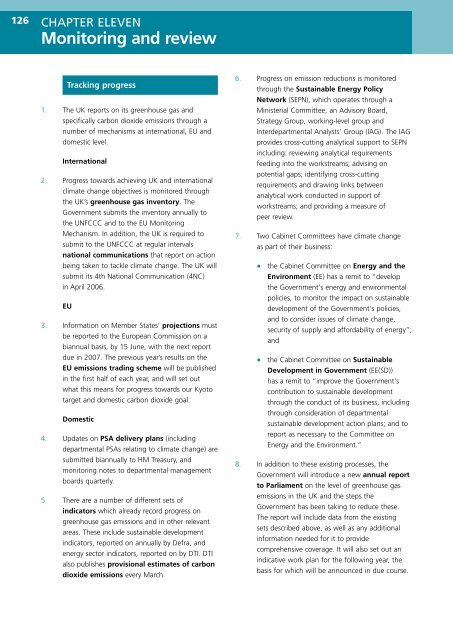UK Climate Change Programme 2006 - JNCC - Defra
UK Climate Change Programme 2006 - JNCC - Defra
UK Climate Change Programme 2006 - JNCC - Defra
Create successful ePaper yourself
Turn your PDF publications into a flip-book with our unique Google optimized e-Paper software.
126<br />
CHAPTER ELEVEN<br />
Monitoring and review<br />
Tracking progress<br />
1. The <strong>UK</strong> reports on its greenhouse gas and<br />
specifically carbon dioxide emissions through a<br />
number of mechanisms at international, EU and<br />
domestic level.<br />
International<br />
2. Progress towards achieving <strong>UK</strong> and international<br />
climate change objectives is monitored through<br />
the <strong>UK</strong>’s greenhouse gas inventory. The<br />
Government submits the inventory annually to<br />
the UNFCCC and to the EU Monitoring<br />
Mechanism. In addition, the <strong>UK</strong> is required to<br />
submit to the UNFCCC at regular intervals<br />
national communications that report on action<br />
being taken to tackle climate change. The <strong>UK</strong> will<br />
submit its 4th National Communication (4NC)<br />
in April <strong>2006</strong>.<br />
EU<br />
3. Information on Member States’ projections must<br />
be reported to the European Commission on a<br />
biannual basis, by 15 June, with the next report<br />
due in 2007. The previous year’s results on the<br />
EU emissions trading scheme will be published<br />
in the first half of each year, and will set out<br />
what this means for progress towards our Kyoto<br />
target and domestic carbon dioxide goal.<br />
Domestic<br />
4. Updates on PSA delivery plans (including<br />
departmental PSAs relating to climate change) are<br />
submitted biannually to HM Treasury, and<br />
monitoring notes to departmental management<br />
boards quarterly.<br />
5. There are a number of different sets of<br />
indicators which already record progress on<br />
greenhouse gas emissions and in other relevant<br />
areas. These include sustainable development<br />
indicators, reported on annually by <strong>Defra</strong>, and<br />
energy sector indicators, reported on by DTI. DTI<br />
also publishes provisional estimates of carbon<br />
dioxide emissions every March.<br />
6. Progress on emission reductions is monitored<br />
through the Sustainable Energy Policy<br />
Network (SEPN), which operates through a<br />
Ministerial Committee, an Advisory Board,<br />
Strategy Group, working-level group and<br />
Interdepartmental Analysts’ Group (IAG). The IAG<br />
provides cross-cutting analytical support to SEPN<br />
including: reviewing analytical requirements<br />
feeding into the workstreams; advising on<br />
potential gaps; identifying cross-cutting<br />
requirements and drawing links between<br />
analytical work conducted in support of<br />
workstreams; and providing a measure of<br />
peer review.<br />
7. Two Cabinet Committees have climate change<br />
as part of their business:<br />
• the Cabinet Committee on Energy and the<br />
Environment (EE) has a remit to “develop<br />
the Government's energy and environmental<br />
policies, to monitor the impact on sustainable<br />
development of the Government's policies,<br />
and to consider issues of climate change,<br />
security of supply and affordability of energy”;<br />
and<br />
• the Cabinet Committee on Sustainable<br />
Development in Government (EE(SD))<br />
has a remit to “improve the Government's<br />
contribution to sustainable development<br />
through the conduct of its business, including<br />
through consideration of departmental<br />
sustainable development action plans; and to<br />
report as necessary to the Committee on<br />
Energy and the Environment.”<br />
8. In addition to these existing processes, the<br />
Government will introduce a new annual report<br />
to Parliament on the level of greenhouse gas<br />
emissions in the <strong>UK</strong> and the steps the<br />
Government has been taking to reduce these.<br />
The report will include data from the existing<br />
sets described above, as well as any additional<br />
information needed for it to provide<br />
comprehensive coverage. It will also set out an<br />
indicative work plan for the following year, the<br />
basis for which will be announced in due course.
















